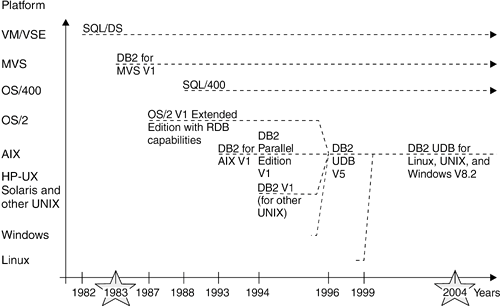Section 1.1. A Brief History of DB2
1.1. A Brief History of DB2Since the 1970s, when IBM Research invented the Relational Model and the Structured Query Language (SQL), IBM has developed a complete family of RDBMS software. Development started on mainframe platforms such as Virtual Machine (VM), Virtual Storage Extended (VSE), and Multiple Virtual Storage (MVS). In 1983, DB2 for MVS Version 1 was born. "DB2" was used to indicate a shift from hierarchical databaseslike the Information Management System (IMS) popular at the timeto the new relational databases. DB2 development continued on mainframe platforms as well as on distributed platforms.[1] Figure 1.1 shows some of the highlights of DB2 history.
Figure 1.1. DB2 timeline In 1996, IBM announced DB2 UDB Version 5 for distributed platforms. With this version, DB2 was able to store all kinds of electronic data, including traditional relational data, as well as audio, video, and text documents. It was the first version optimized for the Web, and it supported a range of distributed platformsfor example, OS/2, Windows, AIX, HP-UX, and Solarisfrom multiple vendors. Moreover, this universal database was able to run on a variety of hardware, from uniprocessor systems and symmetric multiprocessor (SMP) systems to massively parallel processing (MPP) systems and clusters of SMP systems. IBM included the term "Universal" in the name to represent the new capabilities of this version. All versions of DB2 on distributed platforms and on MVS, AS/400, VM, and VSE have adopted the name DB2 UDB. Today, DB2 represents a portfolio of information management products. Table 1.1 shows the DB2 Information Management portfolio and the product offerings under each classification. To specifically refer to database servers, "UDB" needs to be added to the name, as in DB2 UDB. In most books and documents, including this one, the terms "DB2" and "DB2 UDB" are used interchangeably. Unless otherwise noted, when we use any one of these terms in this book, we are referring to DB2 running on Linux, UNIX, or Windows.
|
EAN: 2147483647
Pages: 313